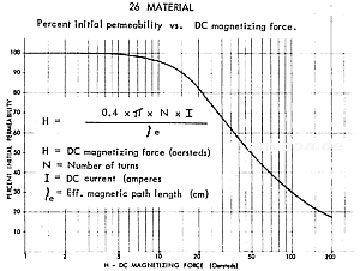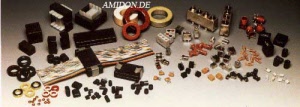 |
DC CHOKES & AC LINE FILTERS 1
IRON POWDER TOROIDAL CORES:
DC CHOKES & AC LINE FILTERS
For many years Iron Powder has been used as the core material for RF inductors and transformers when stability and high 'Q' are of primary concern. Because of the growing need for energy storage inductors for noise filtering, new materials have been developed for these applications.
High 'Q' inductors are no longer required, in fact low 'Q' actually helps damp high frequency oscillations. The #26 Iron Powder material is ideally suited for these applications since it combines low 'Q', good frequency response, and high energy capabilities.
Energy storage, expressed in microjuoles, is calculated by multiplying one-half the inductance in µh times the current in amperes squared. The amount of energy that can be stored in a given inductor is limited either by saturation of the core material or temperature rise of the wound unit, resulting in copper loss and/or core loss.
In typical DC chokes, the AC ripple flux is normally small in comparison to the DC component. Since the DC flux does not generate core loss, our primary concern becomes saturation and copper loss. The DC saturation characteristics of the #26 material are shown in Fig. A on the following page.
Using this information, DC energy storage curves have been developed as shown in the chart on the 2nd following page. A table of energy storage limits vs. temperature rise is included in the chart. The table at the bottom of the page is for single layer winding.
In 60 Hz. line filter applications, the high frequency to be filtered falls into two categories: (1) Common-mode noise and (2) Differential-mode noise. The common-mode noise is in relation to earth ground and is common to both lines. Differential mode noise is the noise between the two lines.
The Common-mode noise filter is usually constructed on a high permeability ferrite type core with a bifilar type winding. This type of winding allows the 60 Hz. flux generated by each line to cancel within the core, thus avoiding saturation. If the #26 Iron Powder material were to be used, the large core size necessary to accommodate the required number of wire turns for the required inductance makes this option unattractive.
The Differential-mode filters must be able to support a significant amount of 60 Hz. flux without saturating. The AC saturation characteristics of the #26 material (Fig. B) and core loss information (Fig. C) can be seen on the following page. Notice how the permeability initially increases with AC excitation. This effect allows greater energy storage in 60 Hz. applications.
Energy storage curves have been developed for line filter applications as shown on the 3rd following page. The energy storage limit table is now taking into account both the core and the copper loss. In order to guarantee a minimum inductance over a wide current range, the design engineer may wish to calculate the required turns based on the listed AL value of the core.
DC CHOKES & AC LINE FILTERS
For many years Iron Powder has been used as the core material for RF inductors and transformers when stability and high 'Q' are of primary concern. Because of the growing need for energy storage inductors for noise filtering, new materials have been developed for these applications.
High 'Q' inductors are no longer required, in fact low 'Q' actually helps damp high frequency oscillations. The #26 Iron Powder material is ideally suited for these applications since it combines low 'Q', good frequency response, and high energy capabilities.
Energy storage, expressed in microjuoles, is calculated by multiplying one-half the inductance in µh times the current in amperes squared. The amount of energy that can be stored in a given inductor is limited either by saturation of the core material or temperature rise of the wound unit, resulting in copper loss and/or core loss.
In typical DC chokes, the AC ripple flux is normally small in comparison to the DC component. Since the DC flux does not generate core loss, our primary concern becomes saturation and copper loss. The DC saturation characteristics of the #26 material are shown in Fig. A on the following page.
Using this information, DC energy storage curves have been developed as shown in the chart on the 2nd following page. A table of energy storage limits vs. temperature rise is included in the chart. The table at the bottom of the page is for single layer winding.
In 60 Hz. line filter applications, the high frequency to be filtered falls into two categories: (1) Common-mode noise and (2) Differential-mode noise. The common-mode noise is in relation to earth ground and is common to both lines. Differential mode noise is the noise between the two lines.
The Common-mode noise filter is usually constructed on a high permeability ferrite type core with a bifilar type winding. This type of winding allows the 60 Hz. flux generated by each line to cancel within the core, thus avoiding saturation. If the #26 Iron Powder material were to be used, the large core size necessary to accommodate the required number of wire turns for the required inductance makes this option unattractive.
The Differential-mode filters must be able to support a significant amount of 60 Hz. flux without saturating. The AC saturation characteristics of the #26 material (Fig. B) and core loss information (Fig. C) can be seen on the following page. Notice how the permeability initially increases with AC excitation. This effect allows greater energy storage in 60 Hz. applications.
Energy storage curves have been developed for line filter applications as shown on the 3rd following page. The energy storage limit table is now taking into account both the core and the copper loss. In order to guarantee a minimum inductance over a wide current range, the design engineer may wish to calculate the required turns based on the listed AL value of the core.
